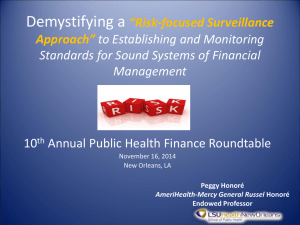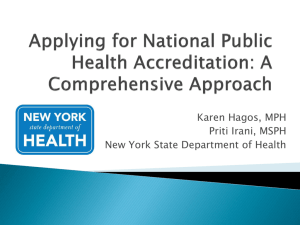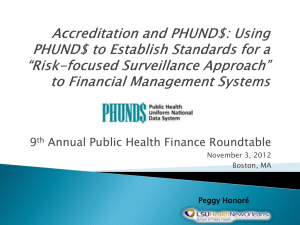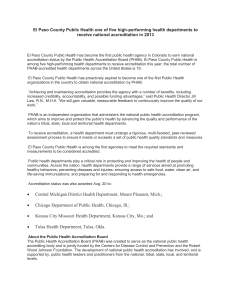Public Health Accreditation
advertisement
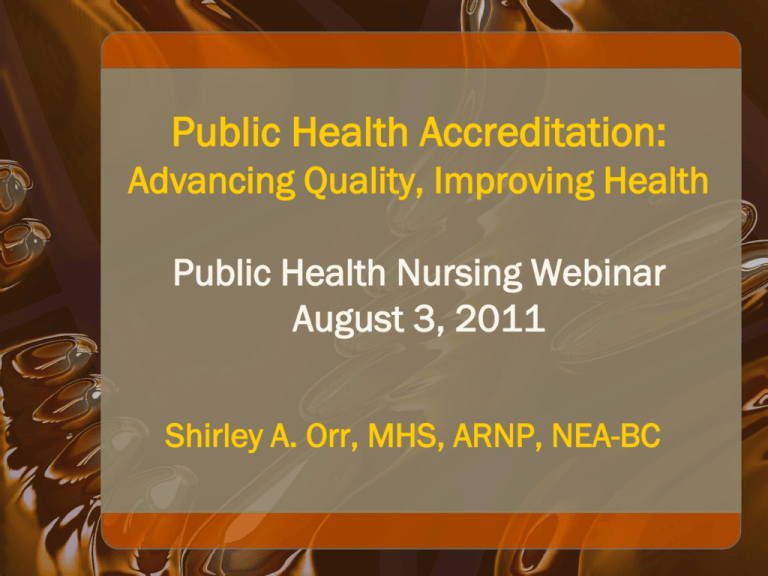
Public Health Accreditation: Advancing Quality, Improving Health Public Health Nursing Webinar August 3, 2011 Shirley A. Orr, MHS, ARNP, NEA-BC Objectives 1. Describe the history and background of the national public health accreditation movement. 2. Explain the framework used for development of the national public health standards and the accreditation process. 3. List the benefits of national standards and accreditation to public health practice. 4. Explain the role of accreditation in advancing public health quality improvement. 5. Identify the potential roles of public health nurses in supporting public health quality improvement and accreditation. What does public health accreditation have in common with The Wizard of Oz? 1939! The Long and Winding Road . . . To Public Health Accreditation • IOM Future of Medicine Report • Core Functions Statement • 10 Essential Public Health Services • National Public Health Performance Standards • Exploring Accreditation Project • Public Health Accreditation Board (PHAB) What is Public Health Accreditation Board (PHAB)? PHAB is a non-profit, voluntary accreditation organization founded in 2007whose goal is to advance public health performance by providing a national framework of standards for local, state, territorial and tribal health departments. PHAB is the national organization charged with administering the public health accreditation program. PHAB is located in Alexandria, VA. PHAB’s Vision High Performing Health Departments Leading to a Healthier Nation PHAB’s Goals Successfully plan and deliver a national voluntary public health accreditation program by 2011—the program will launch this Fall! 60% of the population will be covered by accredited health departments by 2015 PHAB Partners • Association of State and Territorial Health Officials (ASTHO) • National Association of County and City Health Officials (NACCHO) • National Association of Local Boards of Health (NALBOH) • National Indian Health Board (NIHB) • American Public Health Association (APHA) • National Network of Public Health Institutes (NNPHI) • Public Health Foundation (PHF) PHAB Funding Partners • Centers for Disease Control and Prevention (CDC) • Robert Wood Johnson Foundation (RWJF) Benefits of Accreditation • National standards for public health • Shared expectations of public health system “If you’ve seen one health department . . .” • System accountability Outcomes of Accreditation • Evidence-based practice • Culture of quality and performance improvement with measurable outcomes • Public health system focused on achieving improvements in population health CDC Endorsement of Accreditation Who is eligible for accreditation? • Local health departments • State and territorial health departments • Tribal health departments Beta Test 2009-2010 • 148 applications received • All applications could have been chosen • 30 health departments were chosen: 8 state,19 local and 3 tribal • Varying organizational size and configuration • Some state regional/multi county Beta Test Feedback “The standards and measures can be viewed as an operating manual on how to run a good health department. The basics and fundamentals in management are there, so as new leaders come in they don’t have to reinvent the wheel—the standards and measures can provide a consistent roadmap.” Beta Test Health Department Beta Test Feedback The beta test “helped jumpstart the process to create a QI culture for the agency as a whole.” Beta Test Health Department It’s All About Quality • Use of tools and resources to improve programs/services; system quality • Adapting or adopting best practices • Creating a culture of quality in the organization Plan-Do-Check-Act (PDCA) Act Check Plan Do Plan Plan changes aimed at improvement, matched to root causes Do Carry out changes; try first on small scale Check/ Study See if you get the desired results Act Make changes based on what you learned; spread success Also called Plan-Do-Study-Act (PDSA), PDCA, PDCA Cycles, or Shewhart Cycles PDCA Cycle Parallels the Nursing Process… Assess Plan Evaluate Implement Quality in all processes, including PHAB prerequisites Prerequisites for Accreditation • Community health assessment • Community health improvement plan • Agency strategic plan Framework: Domains, Standards, and Measures 12 Domains (10 Essential PH services plus administration & governance) ~Standards ~Measures ~Documentation Twelve PHAB Domains 1. Conduct assessments focused on population health status and health issues facing the community 2. Investigate health problems and environmental public health hazards to protect the community 3. Inform and educate about public health issues and functions 4. Engage with the community to identify and solve health problems 5. Develop public health policies and plans Twelve PHAB Domains 6. Enforce public health laws and regulations 7. Promote strategies to improve access to healthcare services 8. Maintain a competent public health workforce 9. Evaluate and continuously improve processes, programs, and interventions 10. Contribute to and apply the evidence base of public health 11. Maintain administrative and management capacity 12. Build a strong and effective relationship with governing entity Locate, Develop, Select, and Save Best Documentation DOMAIN 1: Conduct and disseminate assessments focused on population health status and public health issues facing the community • Standard 1.1: Participate in or conduct a collaborative process resulting in a comprehensive community health assessment • Standard 1.2: Collect and maintain reliable, comparable, and valid data that provide information on conditions of public health importance and on the health status of the population • Standard 1.3: Analyze public health data to identify trends in health problems, environmental public health hazards, and social and economic factors that affect the public’s health • Standard 1.4: Provide and use the results of health data analysis to develop recommendations regarding public health policy, processes, programs, or interventions Locate, Develop, Select, and Save Best Documentation DOMAIN 2: Investigate health problems and environmental public health hazards to protect the community • Standard 2.1: Conduct timely investigations of health problems and environmental public health hazards • Standard 2.2: Contain/mitigate health problems and environmental public health hazards • Standard 2.3: Analyze public health data to identify trends in health problems, environmental public health hazards, and social and economic factors that affect the public’s health • Standard 2.4: Maintain a plan with policies and procedures for urgent and non-urgent communications Locate, Develop, Select, and Save Best Documentation DOMAIN 3: Inform and educate about public health issues and functions • Standard 3.1: Provide health education and health promotion policies, programs, processes, and interventions to support prevention and wellness • Standard 3.2: Provide information on public health issues and public health functions through multiple methods to a variety of audiences Locate, Develop, Select, and Save Best Documentation DOMAIN 4: Engage with the community to identify and address health problems • Standard 4.1: Engage with the public health system and the community in identifying and addressing health problems through collaborative processes • Standard 4.2: Promote the community’s understanding of and support for policies and strategies that will improve the public’s health Locate, Develop, Select, and Save Best Documentation DOMAIN 5: Develop public health policies and plans • Standard 5.1: Serve as a primary and expert resource for establishing and maintaining public health policies, practices, and capacity • Standard 5.2: Develop and implement a health department organizational strategic plan • Standard 5.3: Conduct a comprehensive planning process resulting in a tribal/state/community health improvement plan • Standard 5.4: Maintain an all-hazards emergency operations plan Locate, Develop, Select, and Save Best Documentation DOMAIN 6: Enforce public health laws • Standard 6.1: Review existing laws and work with governing entities and elected/appointed officials to update as needed • Standard 6.2: Educate individuals and organizations on the meaning, purpose, compliance, and benefit of public health laws and how to comply • Standard 6.3: Conduct and monitor public health enforcement activities and coordinate notification of violations among appropriate agencies Locate, Develop, Select, and Save Best Documentation DOMAIN 7: Promote strategies to improve access to health care services • Standard 7.1: Assess health care capacity and access to health care services • Standard 7.2: Identify and implement strategies to improve access to health care services Locate, Develop, Select, and Save Best Documentation DOMAIN 8: Maintain a competent public health workforce • Standard 8.1: Encourage the development of a sufficient number of qualified public health workers • Standard 8.2: Assess staff competencies and address gaps by enabling organization and individual training and development Locate, Develop, Select, and Save Best Documentation DOMAIN 9: Evaluate and continuously improve processes, programs, and interventions • Standard 9.1: Use a performance management system to improve organizational practice, processes, programs, and interventions • Standard 9.2: Develop and implement quality improvement processes integrated into organizational practice, processes, programs, and interventions Locate, Develop, Select, and Save Best Documentation DOMAIN 10: Contribute to and apply the evidence base of public health • Standard 10.1: Identify and use the best possible evidence for making informed public health practice decisions • Standard 10.2: Promote understanding and use of research results, evaluations, and evidence-based practices with appropriate audiences Locate, Develop, Select, and Save Best Documentation DOMAIN 11: Maintain administrative and management capacity •Standard 11.1: Develop and maintain an operational infrastructure to support the performance of public health functions •Standard 11.2: Establish effective financial management systems Locate, Develop, Select, and Save Best Documentation DOMAIN 12: Maintain capacity to engage the public health governing entity • Standard 12.1: Maintain current operational definitions and statements of the public health roles, responsibilities, and authorities • Standard 12.2: Provide information to the governing entity regarding public health and official responsibilities of the health department and of the governing entity • Standard 12.3: Encourage the governing entity's engagement in the public health department’s overall obligations and responsibilities Preparation for Launching the National Public Health Accreditation Program in Fall 2011 Pre-Launch Materials Out Now! • The Guide to National Public Health Department Accreditation, Version 1.0 • Public Health Department Accreditation Standards and Measures, Version 1.0 • 2011-2012 Accreditation Application Fee Schedule • 2011-2012 Educational Services Offered by PHAB In the Guide: Seven Steps to National Public Health Accreditation Process A. Pre-application: Applicant prepares and assesses readiness checklists, views online orientation to accreditation, and formally informs PHAB of its intent to apply B. Application: Applicant submits application form with pre-requisites, and first fee payment Applicant attends in-person training (included in fees) C. Document Selection and Submission: Applicant selects documentation and submits it to PHAB for review D. Site Visit: Site visit is conducted by a team of peers and report developed E. Accreditation Decision: PHAB Board will award accreditation status for 5 years F. Reports: Accredited health department submits annual reports G. Reaccreditation (5 years later): Accredited health department applies for reaccreditation Accreditation Fees • First fee payment takes into account greater level of effort and costs in the first year. • Fee is broken into eight categories based on population. • Fee covers: - A percentage of the Accreditation Specialist 1:25 - Training and travel for both site visitor and health department accreditation coordinator - Information system costs 2011-2012 Applicant Fee Schedule What do the fees cover? • An assigned accreditation specialist to guide your department through the application process • Site visit, including a comprehensive review of your health department’s operations against the national accreditation standards by a team of peer review experts • In-person training for your department’s accreditation coordinator • 24/7 access to PHAB’s online accreditation information system, making it easier and more cost-efficient for departments to participate in accreditation • Annual quality improvement monitoring and evaluation for 5 years by your accreditation specialist • Access to a growing network of accredited local health departments and best practices Fee Payments • Rates will operate on a sliding scale based on the size of the health department’s jurisdiction • Health departments can receive a discount by paying in advance • Health departments can pay in multiple year increments • Health departments can pay with end of the year grant funds • PHAB’s Fee Schedule will be published annually What should a health department be doing to prepare for national public health accreditation? What are the opportunities for PHNs to contribute? Preparing for Accreditation • Organize Your Health Department – Appoint an Accreditation Coordinator – Review Standards and Measures, Version 1.0 – Review Accreditation Process, Version 1.0 – Educate governance to staff – Contact your national organizations for technical assistance • Work on the Pre-Requisites (Due with Your Application – Department Strategic Plan – State/Community Health Assessment – State/Community Health Improvement Plan Conduct Self-Assessment • Internal expert review • Use accreditation standards and documentation guidelines to conduct objective review against the standards • Identify documentation that shows performance • Identify areas not meeting the standard as areas for improvement • Collaborate/Consult Organize Your Documents • Locate, develop, and save best documentation – Online document library with folders for each standard and measure – PHAB accreditation submittal system • Other electronic submittal tool; e.g. SharePoint, Mind Manager Organize (cont.) • State page number (or highlight with text box) where specific information addressing the measure is located if document more than three pages long • Can use same document for multiple measures – just indicate all measures that are relevant and page of document Tell your story; be concise! • Reviewers will not be familiar with your Health Department or even your state • Provide short summary or note that describes your processes for the topic being addressed • Be “laser focused” on the specific requirement of that measure • Provide only the documentation that is needed to demonstrate performance. More is not better Ways for PHNs to Be Involved • Educate staff and partners about standards and accreditation • Become champion for quality • Review work activities in light of standards--Can your agency/partner efforts provide documentation? • Serve as accreditation coordinator What are the Next Steps? • Review Standards www.phaboard.org • Learn and Implement Quality Improvement www.phf.org • Utilize Resources www.astho.org www.naccho.org • Stay Informed www.phaboard.org THANK YOU! Shirley Orr, MHS, ARNP, NEA-BC Robert Wood Johnson Executive Nurse Fellow shirleyaorr@gmail.com 316.250.6940 Links to the PHN webinar archives • The link to the archives and the PP slides are available at http://sph.bu.edu/otlt/alliance/maphn/ • To view the archive select the session you wish to view, click on the right facing arrow below the large black viewing box and the video will play. • You can also access the archive link and the PP slides on the MAPHN website at http://www.maphn.org/nea2011




